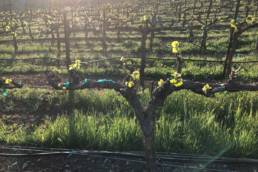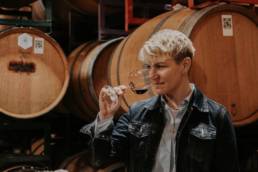FMN – July 2022 – Deciphering Austrian Wine
Trying to stay as diverse as possible in my consumption habits continues to provide a challenge. Although I have my old favorites, I very much like to try new varieties and regions as well as revisit infrequently appreciated past “friends.” In this particular instance, I was subjected to samples of Austrian wines from a beverage PR company and, with much gnashing of teeth, could not recall when that last time I had partaken of this country’s interesting wines. For no reason of purposeful malintent, but rather innocent oversight, these wines have escaped my palate for much too long. Befittingly engulfed in July heat, these Austrian whites are sure to fit the bill for your summer glugging.
 Austria has a long history of a “waxing and waning” wine industry since pre-Roman times. Although wine production existed centuries before, the Cistercian Monks bring the will and knowledge from Burgundy helping to elevate the wine industry of the region. These successes continued for a number of centuries with the industry having to rebuild multiple times due to the religious conflicts with the Turks (17th C), Napoleonic Wars, mildews and Phylloxera (19th C), and the World Wars and diethylene scandal (20th C).
Austria has a long history of a “waxing and waning” wine industry since pre-Roman times. Although wine production existed centuries before, the Cistercian Monks bring the will and knowledge from Burgundy helping to elevate the wine industry of the region. These successes continued for a number of centuries with the industry having to rebuild multiple times due to the religious conflicts with the Turks (17th C), Napoleonic Wars, mildews and Phylloxera (19th C), and the World Wars and diethylene scandal (20th C).
The time immediately before and after the millennium brought renewed hope for the future of Austrian wine. Joining the EU and the revision of wine laws (rewarding quality wine production) was a beneficial and a necessary first step. A seemingly innocuous London Tasting set up by Jancis Robinson MW and Tim Atkin MW in 2002 proved to be Austria’s proverbial “Tasting of Paris” as their Grüner Veltliner and Chardonnay wines took the first four places, showing the world that quality Austrian wine production had returned with a vengeance.
Austria has worked hard to simplify their wine labels in an attempt to make them a bit more consumer friendly thus differentiating themselves further from Germany’s wine labeling. The first element is origin of production and starting with the simplest category of Wein. These can be made anywhere inside Austria and are not permitted to place any specific origin. The next level is Landwein and specifies the wine come from one of three large regions of Weinland, Steireland, or Bergland. Finally, the Qualitätswein (Quality wine) level comes from one of the (now 17) specific wine growing regions. All of these levels have specific criteria ranging from allowed grape varieties, minimal ripeness, minimal alcohol levels, maximum yield, etc.
Austria’s creation of the Districtus Austriae Controllatus (DAC) created a protected designation of origin for the wines in their respective wine growing regions. These are Qualitätswein level that meet further restrictive criteria of their respective wine growing regions. These growing areas have a breakdown, similar to Burgundy, based on where the grapes come from; Regional wines (Gebietswein), Village wines (Ortswein), and single vineyard wines (Riedenwein). Again, the requirements and allowed grape varieties vary for each DAC but always get more restrictive as the named area increases in specificity.
In addition to all that, there is another sub-designation of quality wines (Qualitätswein level), called Prädikatswein, that are based on the grape ripeness levels (sugar content) at harvest. In ascending order of sugar content, they are Spätlese, Auslese, (Beerenauslese, Eiswein, and Strohwein have the same minimums), and Trockenbeerenauslese. With these higher must weights, the final wines display obvious residual sugar but are not cloyingly sweet. The acidity levels are high enough to maintain balance with the residual sugars and are some of the most amazing wines you will ever taste. So those that turn their noses up thinking sweet wines are of lower quality, could not be more incorrect.
Although all these names and terminology seem crazy complicated, the Austrian labels really convey a plethora of information for consumers compared to other countries, especially the United States. With a minimal amount of learning (less than 20 terms) you can really understand exactly what grape, region, location, quality level and approximate sweetness you are getting in that bottle; a much better option than the “buy-and-hope” proposition many undertake with domestic labels.
In addition to a “truth in labeling” approach, Austria has some indigenous grape varieties that are scarcely, if at all, found anywhere else in the world. Although there are some interesting red varieties grown here, St. Laurent, Blaufrankisch and Zweigelt (the crossing of these two previous grapes), over 70% of their production remains with white varieties.
Grüner Veltliner accounts for over a third of area under vine and has become the flagship white variety for Austria, much the same way Sauvignon Blanc has for New Zealand. The one difference is that Grüner probably originated there and is only scantly grown in other regions throughout the world. One would only hope that the other, more rare, indigenous varieties will not fall to vine pull schemes to promote more vineyard area for Grüner (as has occurred in other regions of the world).
Although I am a Grüner fan, there are many other interesting (and often) rare white varieties found in Austrian wine country. The Weißburgunder (Pinot Blanc), Grauburgunder (Pinot Gris), and Rieslings have more of an Alsatian feel versus their German counterparts. Then there are the Welschreislings of Burgenland, and the rare and amazing Roter Veltliner, Zierfandler, and Rotgipfler that are synonymous with everything Austrian.
Although finding these wines are sometimes a challenge as the United States accounts for less than 10% of Austria’s total exports and much of that remains Grüner Veltliner. I challenge you to seek out these wines, any of these wines, and open yourself to a new (old) world that is Austrian wine. Don’t regress, if you can follow Ikea furniture, Pinterest or children’s toy assembly instructions you can certainly master the label lingo for these wines.
Suggested Wines:
Zahel Mauer Wiener Gemischter Satz Ortswein 2020 Vienna $20
To better understand the label, we have to break it into sections. The wine is a regional wine Ortswein from the Weiner (Vienna) region and the winery is Zahel. The additional term “Gemischter Satz” refers to the wine being a field blend of multiple grapes. Field blends were originally done to minimize risk as different varieties are susceptible to different diseases and maladies. When grown, picked and fermented together, the integration of aromas and flavors is seamless.
In this wine there are six different grapes in our field blended wine: Grüner Veltliner, Riesling, Chardonnay, Weißburgunder (Pinot Blanc), Grauburgunder (Pinot Gris), and Traminer. The wine displays an attractive and seductive nose with nuances of orchard fruit (apple, pear), citrus (lime), floral (citrus blossom), tropical fruit and spice (white pepper). The palate is dry with a bright persistent citric acidity that spreads horizontally in the mouth. The body has some recognizable viscosity and a citrus and orchard fruit medley with a brined minerality wrapped around an acidic backbone. This is an easy lateral for those acidophiles consuming Pinot Grigio and Sauvignon Blanc. A great palate cleanser pair with soft cheeses, ceviche, summer salads.
Leth Roter Veltliner Klassik 2020 Wagram $30
The term “Klassik” (Classic) refers to a vintage wine that displays true varietal characteristics, in our case the variety Roter Veltliner. The Leth winery produces this wine from the Wagram region inside Niederösterreich (Lower Austria). The vineyards are kept strictly “natural” with no herbicides used in 25 years, no pesticides in 10 years and no irrigation or fertilizers. Strict selecting of grapes during hand harvesting and gentle pressing pay homage to the regality and scarcity of this variety.
One first notices aromas of rich ripe fruit (peach, pear), melon, pepper spice and a hint of almond. The palate has a slight perception of off-dry but may be related to the ripeness of the fruit. The acidity has a prickly texture that has a slight pleasant bitterness. There is a slight viscous creamy mouth-feel to the body; perhaps an allusion to the sur lie (expired yeast) exposure. The palate mirrors the nose with an added tropical citrus element. An interesting wine that would pair well with charcuterie, firm aged cheeses and bratwurst.
Weingut Stadlmann Rotgipfler Ried Pfaffstättner Tagelsteiner 2017 Thermenregion $30
The Stadlmann winery produces this varietal Rotgipfler from the Thermenregion of Niederösterreich, (Lower Austria). The vineyards are located along the Anninger hill, between the towns of Traiskirchen, Gumpoldskirchen and Pfaffstätten. This area enjoys the cold downdrafts from the alpine hills thus giving significant diurnal temperature changes. This Rotgipfler sees fermentation in large neutral oak and rests on its lees for 5 months.
Initially the wine was a bit closed when first opened and needed a few minutes to fully wake up; not surprising for a white that is over 5 years old. The nose boasts of bruised apricot, tropical fruit, almond, and slight pepper and herbal notes. The palate is dry with a gently sweet warming alcohol. The acidity is broad and slightly subdued by the almost oily viscosity of the body. The pleasant addition of an aged cheesy note on the palate emerges (Sur lie). An all around treat for its rarity and its interesting elements. Pair this wine with the sturdiest of pork dishes (Wiener Schnitzel), sturdy seafood dishes and fondues.




